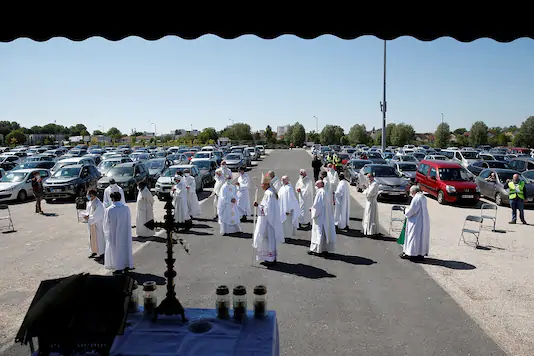Summer not enough to contain Covid-19 Spread, will offer only modest reduction
Mangalore Today News Network
New Delhi, May 18, 2020: The working paper stressed on the caveat that the estimated impact of summer offers only partial relief to some regions of the world and policymakers and public should remain vigilant in their response to the pandemic.
Summer-time temperatures and humidity will not be a potent panacea against COVID-19 and the rise in temperatures will offer only modest reductions in the transmission of the coronavirus, new research has found. It has concluded that the virus transmission will reduce marginally when average temperatures are above 25 degrees Celsius and each 1.8 degree Celsius rise above that would also reduce the reproductive number of the virus, also known as R0 or R naught. Also, higher levels of relative humidity will strengthen the negative effect of temperature above 25 degrees Celsius on transmission of the virus, News18 reported.

Reproductive number denotes the average number of individuals that can get infected because of an infected person. In the absence of prior immunity and any policy response, this number is estimated to be in the range of 2-3 for COVID-19 across many locations, leading to rapid growth in cases, the study said.
The yet to be peer-reviewed study by researchers at Harvard Medical School, Massachusetts Institute of Technology, was published in a working paper. The research comprised examining large datasets of infections and weather conditions at 3,739 locations in the world and its co-relation with what the paper termed as ‘relative Covid-19 rise due to weather’ (CRW). The study also projected the risk of the pandemic going ahead for highly-populous cities, in the context of their weather patterns.
The projections for major cities across the globe showed they go through periods of higher and lower risk during the year. Among Asian cities, the projection showed a downward trend for CRW or rise in cases between the months of May and mid-June and then a slight upward trend in July. The trend slopes downward once again up to the month of October, when winter commences.
The paper cautioned that these risks cannot be associated with absolute reproduction numbers and the estimates are likely to be conservative. It added that the CRW score needs to be low to contain the epidemic on weather conditions alone. Hardly any cities have been projected to achieve this scenario.
The working paper stressed on the caveat that the estimated impact of summer offers only partial relief to some regions of the world and policymakers and public should remain vigilant in their response to the pandemic. “In fact, much of the variation in reproduction number in our sample is explained by location-specific responses, not weather. Ultimately, weather much more likely plays a secondary role in the control of the pandemic,” it said.
- Vittal: 2 suffocate to death when installing ring to well
- Congress will win 24 seats in state, Manjunath Bhandary exudes confidence
- Kota: Rider dies as bike hits divider
- Ullal: Youth dies of cardiac arrest in sleep
- Karnataka HC upholds ban on all types of hookah products
- Belthangady: Leopard preys on domestic dog
- Act against PM Modi: Over 2,200 citizens write to EC over hate speech in Rajasthan
- Fisherman falls off boat; goes missing
- Karnataka government will become bankrupt in next one year: Nalin Kumar Kateel
- Kasaragod: Woman dies after being hit by Vande Bharat Express
- Karnataka HC issues notices on PIL seeking immediate nominations to Karnataka Medical Council
- Udupi: BJP stages protest, says ’women have no protection under Congress govt’
- PM praises BJP candidate Brijesh Chowta’s military background and commitment to development
- "Promised her on the grave...": Neha Hiremath’s father apologises to Karnataka govt
- Congress vs Left after Kerala MLA demands Rahul Gandhi’s ’DNA test’
- Karnataka man hires goons to kill family, plan goes wrong
- LS Elections 2024 | With Rs 5785 cr assets, TDP LS contestant Chandra Sekhar stirs poll attention
- Arvind Kejriwal, K Kavitha To Stay In Jail, Custody Extended By 14 Days
- Supreme Court talks tough, asks Team Ramdev, ’Apology same size as ads?’
- ’Illegal to Hear Hanuman Chalisa’: PM Modi Takes on Karnataka Govt in Rajasthan
- Indian-origin married man kills girlfriend in Singapore, gets 20 years in jail
- Soon WhatsApp users will not require internet to send pictures, files
- 10 Killed after 2 military choppers collide mid-air in Malaysia, Watch
- Snakes on a plane: Man flies from Bangkok with 10 anacondas, arrested in Bengaluru
- Arvind Kejriwal administered insulin in tihar jail after sugar levels soar
- New residential complex for the judges inaugurated in Mangaluru
- Absconding accused nabbed after 8 years
- Truck with cylinders turns turtle in Beltangady
- Bhoota Kola artist dies of cardiac arrest
- Development of the country should be our goal: Ganesh Karnik
- Container truck gets stuck under Modankap railway bridge
- Truck crushes bike’s pillion rider near BC Road
- Head constable dies of heart attack
- Udupi: PDO dismissed over financial irregularities
- CREDAI to resume Skill Development Program for Construction Workers in Mangaluru
- John B Monteiro elected president of Rachana Catholic Chamber of Commerce & Industry
- Sudhanshu Rai elected district president of All College Student Association
- Chief Minister to visit Mangaluru, Udupi on August 1
- Nitte University awards PhD degree to Tina Sheetal D’Souza
- Sachitha Nandagopal honoured by CMTAI for Community Service
- CITY INFORMATION
- TRAVEL
- TOURIST INFORMATION
- HEALTH CARE
- MISCELLANEOUS




 Write Comment
Write Comment E-Mail To a Friend
E-Mail To a Friend Facebook
Facebook Twitter
Twitter  Print
Print 

